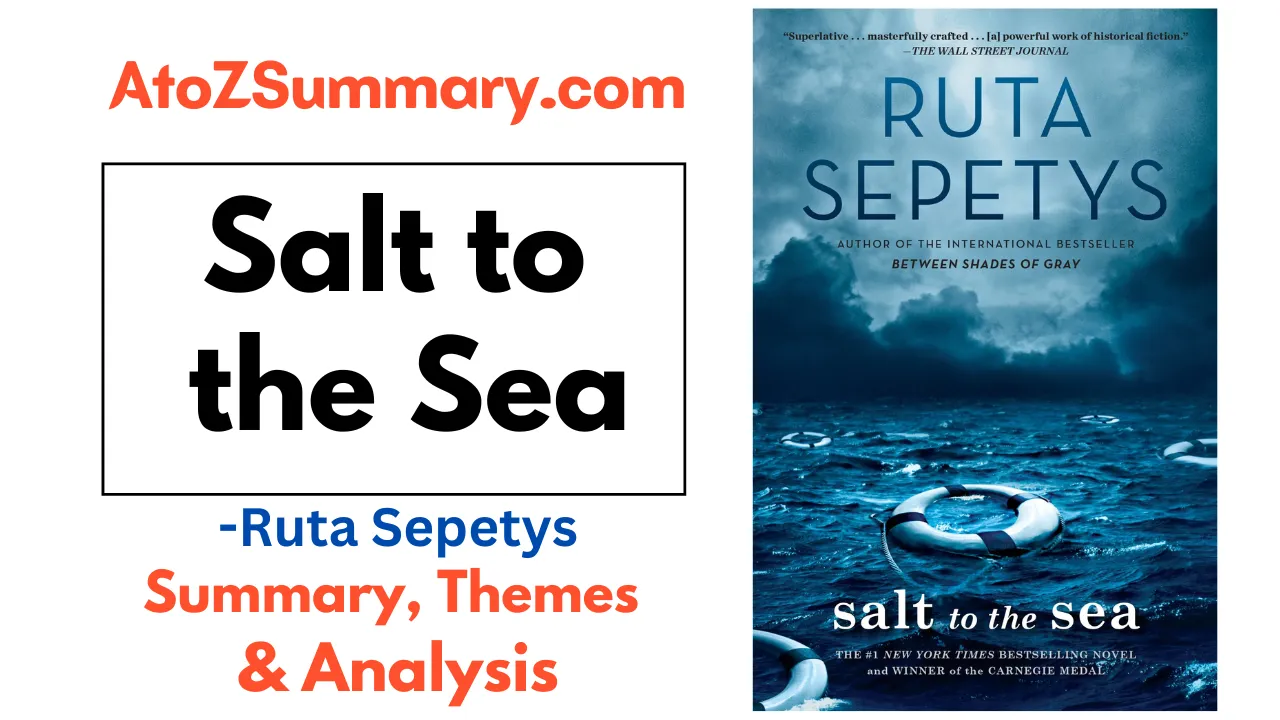| Title | Salt to the Sea |
| Author | Ruta Sepetys |
| Genre | Historical fiction |
| Publication date | February 2, 2016 |
| Setting | East Prussia, 1945 |
| Main Characters | Joana, a Lithuanian nurse Florian, a Prussian artist Emilia, a Polish girl Alfred, a German sailor |
| Plot | The narrative follows four young individuals from various nations as they run away from the Soviet army as it advances during World War II. Hoping to find protection in Denmark, they board the Wilhelm Gustloff, a German ship transporting military troops and civilians. But tragedy comes when a Soviet submarine sinks the ship, becoming one of the greatest maritime catastrophes in history. The storylines of the characters cross as they try to survive and accept their pasts. |
| Themes | War, loss, trauma, identity, family, hope, survival |
| Awards | Carnegie Medal in Literature (2017); Goodreads Choice Award for Historical Fiction (2016); Golden Kite Award for Fiction (2016) |
Introduction
Ruta Sepetys’ historical fiction novel “Salt to the Sea” is set during World War II. Four young people from various origins are being followed by the narrative as they attempt to find safety on a ship called the Wilhelm Gustloff. However, it becomes apparent that safety is not assured as the ship travels across the Baltic Sea.
Themes
- The horrors of war- Salt to the Sea examines the terrible effects of World War II on common people, emphasizing the crimes done by the Nazis and the toll that war has on both soldiers and civilians.
- Survival and resiliency- Despite the challenging situations they encounter, the characters in Salt to the Sea show exemplary strength and resiliency as they confront the difficulties of war and make every effort to survive.
- The strength of hope- In Salt to the Sea, hope emerges as a strong force in the midst of such enormous sadness. The protagonists battle through their difficulties because they hold onto the notion that things will improve even in the most dire circumstances.
- Identity and belonging- These topics are explored in Salt to the Sea because the protagonists, who come from many nations and cultures, must negotiate their differences while simultaneously figuring out how to relate to one another.
- Guilt and redemption- The characters in Salt to the Sea struggle with guilt about their previous choices or perceived failings, but they also look for atonement by displaying bravery and altruism.
- The human cost of war- Salt to the Sea serves as a somber reminder of the cost that conflict takes on its victims. We witness the effects of war on people, families and communities via the experiences of the characters, and we are encouraged to make an effort to live in peace and understanding.
Characters
Here are the main characters in “Salt to the Sea”:
- Joana- A nurse from Lithuania who was torn away from her family during the war. She is a tenacious and self-reliant individual who manages her circumstances and makes an effort to assist others who are in need.
- Florian- A Prussian art restorer who, after stealing a priceless masterpiece of art, is escaping the Nazis. He has a sympathetic side but is also reserved and secretive.
- Emilia – Emilia is a 15-year-old pregnant Polish girl who is traveling by herself. She is innocent and defenseless but yet resolute in her desire to live and safeguard her unborn child.
- Alfred – A member of the Kriegsmarine, Alfred is a young German sailor. Hitler is his idol and he is preoccupied with spreading propaganda, but he also fights with timidity and feelings of inadequacy.
- Eva – A young German woman who is also a Kriegsmarine soldier. She becomes friendly with Joana and the other migrants on board the Wilhelm Gustloff because she is kind and caring.
- Heinz – A middle-aged German guy traveling with his young son Klaus, is in the group. He has a strong sense of patriotism and supports the Nazi cause, but he also wrestles with his conscience and has second thoughts about the war.
Watch Full Novel Summary Video
Salt to the Sea Summary (In Parts)
Part 1: Joana
Joana, a young Lithuanian nurse who is traveling with a small group of immigrants toward the shore of Germany, is introduced at the start of the book. The conflict has split Joana’s family apart, leaving her as the lone survivor.
She decides to go with a bunch of strangers who are all headed in the same direction in search of safety and a fresh start. As the group’s leader, Joana assumes leadership qualities and ensures that everyone is fed, housed, and safeguarded.
Part 2: Florian
In the second part of the novel, we first meet Florian, a young German man suspected of robbing a wealthy family of a rare treasure. Florian had to leave his house due to circumstances.
Florian’s trip to the Wilhelm Gustloff, which focuses on survival, involves him avoiding officials who are hunting him.
Young Emilia is a girl Florian meets along the way who has been left behind by her family and is in desperate need of help. Emilia is taken under Florian’s wing with a pledge to look out for her.
Part 3: Emilia
Emilia, a little Polish girl who is traveling by herself in search of her family, is featured in the third section of the book.
As Emilia endures horrible acts of brutality and observes the horrors of war, her path is wrought with sorrow and heartache.
As she never loses faith that she will someday be reunited with her loved ones, Emilia’s narrative is one of tenacity and optimism.
Part 4: Alfred
Alfred, a teenage sailor assigned to the Wilhelm Gustloff, is first introduced to us towards the book’s conclusion. Alfred, who belongs to the Hitler Youth, was indoctrinated into adopting the Nazi philosophy.
Alfred starts to doubt his convictions and his part in the war as he observes the misery and tragedy going on all around him. As he comes to face the reality about the world and himself, Alfred embarks on a voyage of self-discovery.
Part 5: The Wilhelm Gustloff
The Wilhelm Gustloff is the setting of the book’s turning point, whereby all four of the central figures are finally brought together.
As the ship leaves port, arguments and rising tensions reveal substantial rifts in the relationships of the passengers. The passengers must unite and cooperate in order to survive the awful tragedies that the ship encounters.
Examining the aftermath of the calamity and its effects helps to bring the story to a satisfying conclusion.
FAQs
What is “Salt to the Sea” about?
The historical fiction novel “Salt to the Sea” portrays four young adults from different backgrounds as they try to flee Nazi-occupied Europe during World War II. They are all drawn to the Wilhelm Gustloff, which is traveling to Germany for safety.
Is “Salt to the Sea” based on a true story?
Yes, the sinking of the Wilhelm Gustloff occurred during World War II and was a real historical event. The novel’s characters and their experiences are totally made up despite the author’s extensive study to ensure historical accuracy in the event’s representation.
What is the writing style of “Salt to the Sea” like?
Readers are drawn into the story’s universe and cast of people because to Ruta Sepetys’ lyrical and symbolic writing. The four main protagonists’ individual experiences and motivations are explained to readers because the novel is written from their perspectives.
What age group is “Salt to the Sea” intended for?
Although “Salt to the Sea” is geared for young adults, readers of all ages will love it.










![Regretting You Summary, Themes, Synopsis & Characters [Book by Colleen Hoover] Regretting You Summary, Themes, Synopsis & Characters [Book by Colleen Hoover]](https://atozsummary.com/wp-content/uploads/2023/05/Regretting-You-Summary-Themes-Synopsis-Characters-Book-by-Colleen-Hoover-1024x576.webp)
